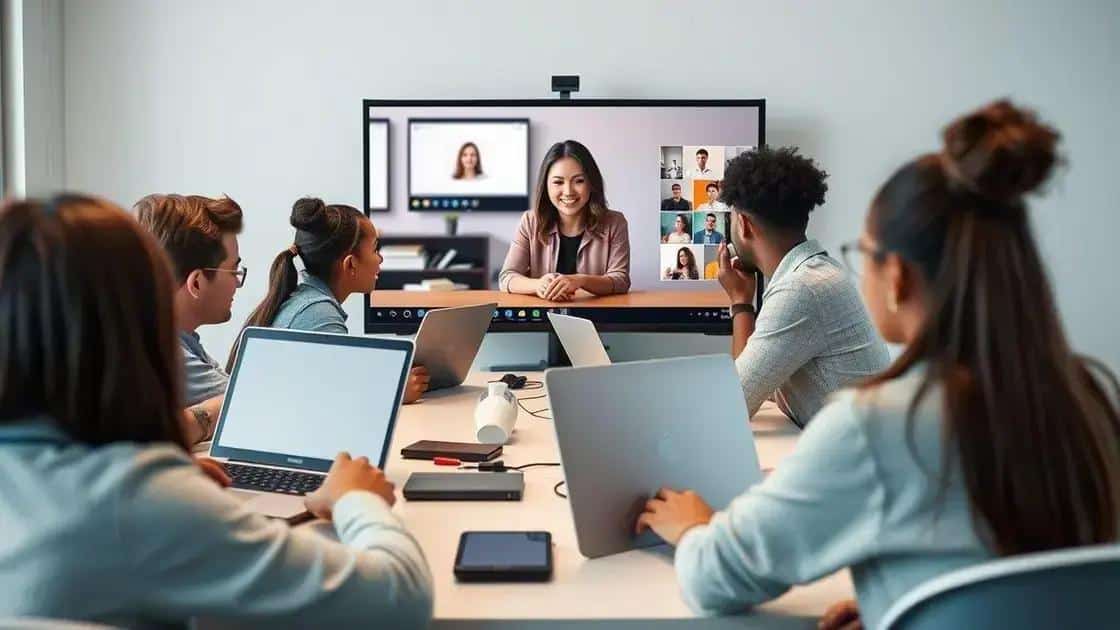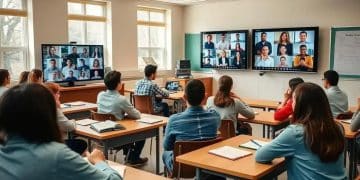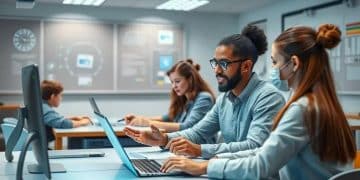Remote learning platforms trends: what’s next for education?

Remote learning platforms face challenges such as unequal technology access, maintaining student engagement, and the need for effective time management, all of which educators must address for successful online education.
Remote learning platforms trends are transforming educational experiences for students and teachers alike. Have you noticed how quickly these changes are evolving? Let’s delve into what’s shaping the future of online education.
The rise of interactive learning technologies
The rise of interactive learning technologies is reshaping education as we know it. These innovations create more engaging and efficient learning experiences. Students today are experiencing classes that are not only informative but also interactive.
What Are Interactive Learning Technologies?
These technologies include a range of tools used to enhance the learning experience. They can be anything from software to physical devices that allow students to engage beyond traditional methods. Examples include:
- Virtual reality (VR) that immerses students in 3D environments.
- Gamification elements that make learning fun and competitive.
- Collaborative platforms that allow students to work together in real-time.
- Interactive simulations that provide practical experience.
With interactive platforms, learning becomes a two-way street. Instead of passively listening, students can now actively participate. For example, using video conferencing tools, teachers can guide discussions in real-time, making the lessons more dynamic.
Benefits of Interactive Technologies
The benefits of these interactive technologies are clear. They cater to different learning styles, making education accessible to everyone. Moreover, engagement in learning has shown to increase retention rates significantly. As students interact more with content, they often understand and remember better.
Another notable advantage is the ability to obtain immediate feedback. With online quizzes and interactive features, students can quickly see areas where they need improvement. This creates a personalized learning experience tailored to each individual’s needs.
In addition to making education more inclusive, these tools also prepare students for the future workplace. Being proficient in these technologies can give students a competitive edge in their careers.
As we continue to embrace these interactive learning technologies, it’s essential that educators remain adaptable. The landscape of education is constantly evolving, and those who can adapt will thrive. These innovations are not just fleeting trends; they are a glimpse into the future of education.
Key features of successful remote learning platforms

When we think about successful remote learning platforms, certain key features stand out. These features make learning effective and enjoyable for both students and teachers. It’s essential to understand what to look for in these platforms.
User-Friendly Interface
A user-friendly interface is crucial for enhancing the learning experience. When students can easily navigate a platform, they spend less time figuring it out and more time learning. A clean design, intuitive menus, and clear buttons ensure that users of all ages can access content without frustration.
Engagement Tools
Another important aspect is the presence of engagement tools. These tools help to keep students involved and motivated. Some of the most effective tools include:
- Interactive quizzes that provide instant feedback.
- Discussion forums that foster collaboration among peers.
- Live chat features for real-time assistance from educators.
- Multimedia resources, such as videos and podcasts, that enhance learning.
By incorporating these tools, a remote learning platform can transform a passive learning experience into an active one. Students feel more connected and engaged when they can share ideas and ask questions.
Accessibility Options
Accessibility is another critical feature that shapes the success of remote learning platforms. They must be designed to accommodate diverse learners, including those with disabilities. This can include:
- Text-to-speech functionality for visually impaired students.
- Subtitles for videos to assist those who are hard of hearing.
- Customizable layouts for individual learning preferences.
When platforms prioritize accessibility, they ensure that all students can succeed regardless of their unique challenges.
Security is also vital for safe remote learning. Platforms should have robust measures in place to protect students’ personal information. Secure logins, regular data encryption, and compliance with privacy regulations are essential.
Finally, effective analytics tools are important for tracking progress. Teachers and administrators can benefit from data that shows how students are performing. This information can inform instructional strategies and identify areas that need improvement, ensuring that learning remains personalized and effective.
Future trends in remote education
The future trends in remote education are poised to transform the way we learn and teach. As technology evolves, so do the methods and tools used in education. This shift is making learning more accessible and personalized than ever before.
AI and Personalized Learning
One significant trend is the integration of artificial intelligence (AI) to tailor the learning experience. AI can analyze student performance and adapt materials accordingly. This means that:
- Students receive recommendations based on their individual needs.
- Learning paths can be customized to address strengths and weaknesses.
- Real-time feedback helps students improve faster.
Such personalization enhances engagement and maximizes learning potential, allowing for a more relevant educational experience.
Increased Use of Virtual Reality
Another exciting trend is the use of virtual reality (VR) and augmented reality (AR) in education. These technologies create immersive learning environments. For instance, students can:
- Explore historical sites without leaving their homes.
- Participate in science experiments in a safe virtual lab.
- Engage with complex concepts through interactive simulations.
By making learning experiences more interactive, VR and AR help solidify understanding and retention of information.
Collaborative tools are also evolving, allowing students and teachers to connect across the globe. These platforms enable real-time communication and project collaboration, bridging geographical barriers. This global interaction enriches students’ cultural awareness and promotes teamwork skills.
Furthermore, we can expect a greater emphasis on well-being in education. Platforms are starting to include mental health resources and tools to support emotional learning, recognizing how important this aspect is for student success.
Finally, we will likely see a more hybrid approach in education, blending online and in-person learning. This flexibility allows students to benefit from the best of both worlds, catering to diverse learning styles and preferences. The future of education will continue to evolve, embracing change and innovation to better equip learners for the challenges ahead.
Challenges in adapting to remote learning

Adapting to remote learning comes with various challenges that both students and educators face. Understanding these obstacles is vital to ensuring a smoother transition into online education. Some of the most common issues include technology access, engagement, and the need for self-discipline.
Technology Access and Infrastructure
One major challenge is that not all students have equal access to technology or reliable internet. This digital divide can create disparities in learning opportunities. For instance, students without computers cannot participate fully in online classes. Those with slow internet connections may struggle to access resources effectively. Such inequities can lead to frustration and hinder the overall learning experience.
Engagement and Motivation
Another challenge is keeping students engaged in a remote learning environment. In traditional classrooms, teachers can easily gauge students’ attention and adapt their lessons. However, in online settings, it’s harder to maintain that level of interaction. Some strategies to enhance engagement include:
- Incorporating interactive elements like polls and discussions.
- Utilizing multimedia content to make lessons more dynamic.
- Implementing gamified learning approaches to motivate participation.
These strategies can help bridge the gap and make learning more enticing for students.
Self-Discipline and Time Management
Additionally, many students struggle with self-discipline and time management in a remote learning setup. Without the structure of a traditional classroom, students may find it challenging to stay focused and complete assignments on time. To combat this issue, students can:
- Create a dedicated study space free from distractions.
- Establish a consistent daily schedule for learning.
- Set clear goals and deadlines for assignments.
By developing these habits, students can enhance their productivity and create a more effective learning environment.
Furthermore, teachers also face challenges in evaluating student performance accurately. In a remote setting, it can be difficult to assess how well students understand the material. Assessments may need to be adjusted to suit online formats, which requires additional planning and creativity.
Addressing these challenges is key to making remote education successful. With a focus on understanding and adapting to these obstacles, both educators and students can work towards more effective remote learning experiences.
FAQ – Frequently Asked Questions about Remote Learning
What are the main challenges students face in remote learning?
Students often struggle with technology access, maintaining engagement, and managing their time effectively.
How can educators keep students motivated during remote classes?
Incorporating interactive elements, such as polls and multimedia content, can enhance motivation and engagement.
What strategies can help students manage their time better in a remote setting?
Creating a dedicated study space, establishing a daily schedule, and setting clear goals can improve time management.
How important is collaboration between students and teachers in remote learning?
Collaboration is crucial as it fosters a supportive learning environment and helps address challenges more effectively.





